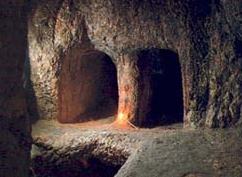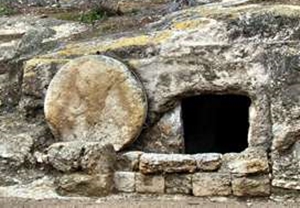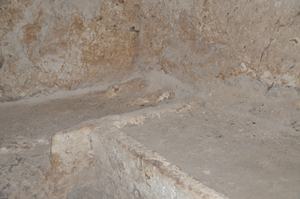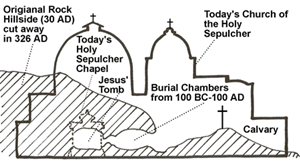Does the tomb of Jesus really exist? Is there any archeological evidence that validates the biblical record?
What the Bible records
Jesus was crucified at the place call Golgotha (Matt 27:33;
Mark 15:22; John 19:17),
which in Aramaic means "Skull." Little is really known of what Golgotha described or represented, and
archeologists are left with several questions.
Did it describe the appearance of the hill?
Did it represent a place of execution or suffering?
Did it describe a place where bones were scattered?
The gospels record the location of Golgotha as being outside the walls of Jerusalem
(John 19:20) and near a well traveled road
(Matt 27:39; Mark 15:29);
but, the gospel accounts are silent as to whether Golgotha was a hill.
When the gospel accounts from the cross to the tomb are combined
(Matt 27:57-61; Mark 15:42-47;
Luke 23:50-56; John 19:38-42),
this narrative emerges:

A "First Temple" tomb
© Bib-arch.org
After this, when it was already evening, a man named Joseph went to Pilate. He was a
rich man from the Jewish city of Arimathea, a disciple of Jesus (though he kept it a secret for fear of the Jews),
and was looking for the kingdom of God. He was a reputable member of the Sanhedrin, a good and just man who had
not agreed with their decision and actions. Since it was Preparation, the day before the Sabbath, he boldly went
to Pilate and asked for permission to take away the body of Jesus.
Pilate was surprised to hear that He was dead so soon, so he called for the centurion
asked whether Jesus had already died. On learning that it was so, he granted the body to Joseph.
Joseph then bought fine linen cloth and went and took down the body. Nicodemus also
came, the man who at the beginning came to Jesus at night, bringing a mixture of myrrh and aloes weighing about
seventy-five pounds. They took away the body of Jesus and wrapped it in the clean linen cloths along with the
spices, according to the Jewish burial custom.
Near the place where He was crucified was a garden, and in it was an unused tomb that
Joseph had newly carved out of the rock. Since this was Preparation Day and the Sabbath was imminent, they laid
Jesus there because the tomb was so close. Then they rolled a large stone against the door of the tomb and left.
The women who came with Jesus from Galilee had followed – Mary Magdalene and the other
Mary, the mother of Jesus – and as they sat across from the tomb, they saw where and how His body was laid. They
rested on the Sabbath day in observance of the commandment.

A "Second Temple" tomb
with a rolling stone door
From this narrative, several observations can be made about the tomb:
The tomb was in a garden near the place of crucifixion
(John 19:41).
The tomb was cut out the rock (Matt 27:60).
The tomb was a new tomb originally created for Joseph of Arimathea
(Matt 27:60).
The tomb had a large rolling stone that could cover the entrance
(Matt 27:60; Mark 15:46;
16:4).
From the accounts of the resurrection, some additional information about the tombs can be seen:
The tomb was large enough for someone to sit down inside
(Mark 16:5; John 20:12).
The tomb required one to stoop down to look inside and enter
(John 20:5-6, 11; Luke 24:12).
As an ancient city, Jerusalem has a variety of tombs which have been in continuous use for several generations
of a family; thus, they have been used and reused over many centuries. These tombs have a few main features:
Doorway: this rock cut entrance led into a small cave area.
Niche: this was a hole in the rock that could accommodate a whole body.
Rock bench: this was a rock shelf upon which a body could be prepared then placed into a niche
or prepared and left there.
Combined with dating of artifacts such as grave goods, pottery shards or organic material found in the tombs,
stratigraphic location of the tombs, tomb architecture, and inscriptions, archeologists have found some distinctive
features and burial practices that determine whether a tomb was constructed during the first or second temple period.

First Temple tomb: hewn from stone, these
2 rock benches lie perpendicular to each other
First temple tombs were rock hewn burial caves with niches or wide rock-cut benches that were
usually cut into the walls of the burial chamber. They sometimes included a raised headrest, After the body had
decomposed, a space cut out beneath the benches served as long term repositories for bones so that the bench would
be available for use again.
The second temple period (515 B.C. – 70 A.D.) featured tombs that were similar to the first temple
period; however, the Jewish tomb of the Herodian period (30 B.C – 70 A.D.) typically used stone chests with lids
called ossuaries. In contrast to the first temple period, when the bones of the deceased were placed in a common
repository, the second temple period placed the bones of the deceased into their own ossuary for a second burial
if the deceased had a belief in the resurrection of the dead.
Where is the true location of Jesus’ tomb?
With the passage of time, the exact location of Jesus’ tomb is uncertain; but, most scholars believe that the
location is marked by the Church of the Holy Sepulcher. Since 1883, some consider the Garden Tomb or Gordon’s Calvary
as the true location of Jesus’ Tomb.
The Garden Tomb or Gordon’s Calvary was discovered when British General Charles Gordon visited
Jerusalem in 1883; he thought that he found the true location of Golgotha. The ridge was skull like in appearance and
close to the location of a garden tomb, discovered earlier in 1867, with a stone groove which could have housed a large
stone.
However archeological evidence suggests that the Garden Tomb may have been hewn in the time of the
Old Testament (some 700 years before the time of Jesus), and the stone groove may have been a water trough for animals.
Because Christian Crusaders used this location as a stable, it clearly was not considered a holy site. Even earlier,
Byzantine Christians (300-600 A.D.) did not consider it a holy site either.
The Church of the Holy Sepulcher is believed to be built over the true site of Jesus’ crucifixion and burial.
Although one cannot be certain of the location of Jesus’ tomb, there is little reason to reject the authenticity of
the site. Archeology has confirmed the following facts about the location of the Church of the Holy Sepulcher:
1. In 30 A.D., before the Church of the Holy Sepulcher was built, the area was outside Jerusalem’s
city walls.
2. Several first century tombs have been discovered on site.
3. At the turn of the era, the area was a large burial ground.
4. In about the seventh or eighth century BC, the area was once a large limestone quarry.
5. From the time of Christ, Jerusalem had a continuous Christian community, and despite the
construction of the Church of the Holy Sepulcher in 335 A.D., the location of Jesus’ tomb was well known and was at
the same location for 300 years.
What is remarkable to consider is that by 326 A.D., when the location was pointed out to
Constantine’s mother Queen Helena:
1. Jesus’ tomb was located within Jerusalem’s city walls.

© Generationword.com
2. Jewish leaders of the first century did not condone burials west of the city.
3. Hadrian’s Temple to Aphrodite was built over the tomb of Christ to assert Roman rule,
prevent another Jewish revolt, and destroy Christian holy places of worship.
Because of these factors, it seems apparent that the tomb of Christ was well known and without
dispute.
While this information is known and passed down by tradition, it has been very difficult to confirm the authenticity
of this location for Jesus’ tomb. Over the past two thousand years, there are no fewer than 4 structures that were built
over the tomb of Jesus (4th, 11th, 16th 19th centuries) which can be seen in this brief history.
Eusebius (263-339 A.D.), a Roman historian and Bishop of Caesarea, records that Jesus’ tomb became a place of
veneration until sometime around 130 A.D. when the Roman Emperor Hadrian, as an expression of his distain of Christianity,
covered the site and built a large temple to the goddess Venus.
Around 325 B.C., Emperor Constantine I ordered that the Roman temple be demolished and the site excavated, and
directed his mother, Helena to commemorate the life of Jesus by building churches on significant sites. Consequently
the Church of the Nativity was built in Bethlehem to celebrate the birth of Jesus and the Church of the Holy Sepulchre
memorialized the crucifixion and tomb of Christ.

© Generationword.com
Eusebius, present at the excavation and construction of the Church of the Holy Sepulchre, records,
"contrary to all expectation, the venerable and hollowed monument of our Savior's resurrection was discovered." The tomb
of Christ apparently had visible proof attesting to its authenticity; however, Eusebius does not record what the visible
proof was.
According to tradition, the tomb was isolated and preserved by having its surrounding rock removed
so that it was a free standing rock hewn tomb. An aedicule, or small shrine or temple characteristic of Roman funeral
architecture, was built enclosing the tomb.
The Aedicule had a five column octagonal marble structure over the tomb and a four columned porch
over the forecourt.
Over the Aedicule was the circular basilica known as the Rotunda or Anastasis (meaning resurrection)
completed at the end of the 4th century.
Another basilican church known as the Marturion (meaning: testimony) contained Golgotha which was
the rock hill that Jesus was crucified on.
In 1009, the Muslim ruler, the Caliph al-Hakim, destroyed the Rotunda, most of the Aedicule and the Marturion.
Christian pilgrims visiting the site shortly after its destruction indicate that the tomb was not completely destroyed.
Some of the tomb’s walls and bench upon which Jesus’ body would have been laid was relatively undamaged.
Started in 1036 and completed by 1048, the church was rebuilt with a new Aedicule; however, this new church was
smaller than the original built by Constantine.
When the Crusaders retook Jerusalem in 1099, a larger church was built which took thirty years to complete. This
building is largely the current Church of the Holy Selpuchre.
In 1555, due to neglect, the Aedicule was renovated by Franciscan friars.
In 1808, a large fire caused the Rotunda’s dome to collapse and smashing parts of the Aedicule. Rebuilt within
two years, the Rotunda and Aedicule was renovated and restored; however, the dome of the Rotunda was not completely
rebuilt until 1868.
Because of the destructive nature of archeological digs, it is currently impossible to verify the location of Jesus’
tomb; however, a unique thermal study was allowed by authorities which provided compelling evidence of the tomb’s
existence within the Aedicule seen in a video by the PBS series "Secrets of the Dead: The Tomb of Christ"
(season 2, episode 5), featuring a scientific team led by Oxford professor Martin Biddle.
Copyright ©
2013
Helpmewithbiblestudy.org. All rights to this material are reserved. We encourage you to print the material for personal and
non-profit use or link to this site. If you find this article to be a blessing, please share the link so that it may rise in
search engine rankings.